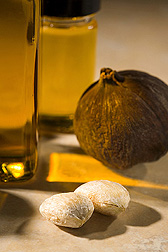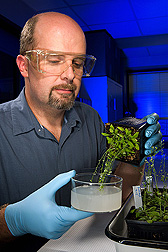Tung Twister
Powerful enzymes from tung trees
could turn plants into oil-producing marvels.
|
|
What do yeast, an exotic fruit tree, and the model plant Arabidopsis have to do with solving the world’s energy problems?
According to ARS scientists at the Southern Regional Research Center (SRRC) in New Orleans, Louisiana, the unique attributes of these three organisms are converging in a
project aimed at producing novel oils that could someday rival petroleumin certain industrial uses—or even improve human health.
Chemist John Dyer and plant geneticist Jay Shockey in SRRC’s Commodity Utilization Research Unit are trying to take the mystery out of how certain plants, like the tung tree, produce high levels of unusual fatty acids. Once they fully understand these complex inner workings, as carried out in the tiniest plant cell, they’ll be closer to genetically engineering oilseed crops capable of churning out abundant designer oils.
Beyond the Kitchen
Oilseed crops are major agricultural commodities. Last year, more than 395 million metric tons of them were produced worldwide. Most of these oils, extracted from crops such as corn, soybeans, cottonseed, and peanuts are grown for food purposes.
But, says Dyer, “Probably the greatest potential for oilseed crops lies in manipulating their fatty acid content to improve their chemical and industrial properties.”
Seed oils, says Dyer, are chemically similar to crude oil and could supply renewable raw materials for making a range of industrial goods—from inks and coatings to plastics and fuels.
And with the right coaxing, plants can also produce fatty acids important for human health, such as fish oil-type fatty acids that are good for the heart, brain, and eyes.
But attempts to genetically engineer plants that will practically ooze valuable oils are still being assembled on a laboratory scale. “And they’re only producing modest amounts of oils,” says Shockey, who’s keeping vigil over a patch of oil-making Arabidopsis plants in his lab. He has gotten the plants to make a fatty acid called “eleostearic
acid,” something they wouldn’t normally do.
To achieve the necessary yields, scientists need a better understanding of which plant genes govern the flow of oil production. Helping grease the wheels of this research are recent plant-cell studies conducted by Dyer and Shockey.
|
|
Tung: A Model Oil
The tung tree, a China native brought to the West several centuries ago, is the source of tung oil. Familiar to those who finish furniture, tung oil is capable of lending a tough, water-resistant seal to almost any surface—including wood, stone, and even plastic.
The oil is composed mostly of eleostearic acid, an unusual conjugated fatty acid that can polymerize, or harden, in the presence of oxygen. Brush a coat of tung oil onto a teak chair and it quickly becomes one with the wood. Try the same thing with ordinary vegetable oil and it globs up, resisting absorption.
Unfortunately, despite tung oil’s impressive chemical resume, the trees that produce it have weak agronomic attributes. In the southern United States, only about 5,000 acres of tung trees are grown, and they suffer from occasional lashings by tropical storms and hurricanes.
First it was Camille in 1969 and then Katrina in 2005 that indelibly scarred the Gulf region’s tung industry. “The orchard near Lumberton, Mississippi, where we used to get seed and leaf samples, was devastated by Katrina,” says Shockey. Proof of how vulnerable the U.S. tung industry is: This single orchard produced 15 to 20 percent of the domestic annual supply of tung oil.
Enzymes Power the Oil-Making Machinery
Given tung’s unique qualities, coupled with the challenges surrounding its cultivation, Dyer and Shockey believe the most logical approach is to endow easy-to-grow, conventional plants, like soybeans, with the ability to pump out tung oil and other specialty oils. But before they can do that, the researchers need to account for all the major enzymes involved in oil synthesis. They’ve already pinpointed several of these in tung plants, including the enzyme that produces eleostearic acid.
More recently, the SRRC researchers have uncovered vital information about two of the plant’s most pivotal enzyme players for determining the types and amounts of fatty acids that accumulate in oil: DGAT1 and DGAT2—short for diacylglycerol acyltransferase type 1 and type 2.
DGAT isn’t unique to tung trees or even to plants in general. In fact, in humans, it helps to produce triglycerides, one of the major lipids, or fats, found in our bloodstream. It does a similar thing in plants.
“The plant lipid research community has known for 40 years about the basic pathway directing oil synthesis,” says Shockey. “We’ve also known that that last step, involving DGAT, is one of the most important.”
What Dyer, Shockey, and colleagues at the University of Guelph in Ontario, Canada, were able to determine beyond those two facts, as outlined in a paper published last year in The Plant Cell, is exactly how the two enzymes differ.
“Ours are some of the first findings showing that the two DGAT enzymes are not equal,” says Shockey. “We think DGAT2 may have evolved to fulfill a particular oil-production niche in many oilseeds, including tung seeds, while DGAT1 exists as more of an all-purpose, housekeeping enzyme.”
Dyer and Shockey now know that to successfully engineer unusual fatty acids from plants, they’ll want to focus on the DGAT2 enzyme. It could also be a key to producing large quantities of oils in plants—one of the last frontiers for oilseed engineers.
Additional genes will certainly be needed before any oil-producing plant or microorganism can reach its full potential. But with every new discovery, the ARS researchers are getting closer to their goal—helping the country shift from the current crude-oil-based economy to a sustainable, biobased one.—By Erin K. Peabody, Agricultural Research Service Information Staff.
This work is part of Quality and Utilization of Agricultural Products, an ARS national program (#306) described on the World Wide Web at www.nps.ars.usda.gov.
John M. Dyer and Jay M. Shockey are with the Southern Regional Research Center, 1100 Robert E. Lee Blvd., New Orleans, LA 70124; phone (504) 286-4351 [Dyer], (504) 286-4296 [Shockey], fax (504) 286-4419.
"Tung Twister" was published in the August 2007 issue of Agricultural Research magazine.









